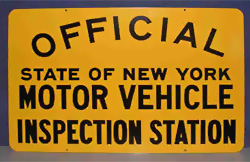Understanding the New York State Automotive Safety Inspections Requirements (Part 3)
This is part 3 of our series on New York State safety inspections.
· Click here for part one.
· Click here for part two.
Emissions inspections for cars and light trucks
The Federal Clean Air Act passed in 1990 requires that the New York State carries out an inspection program towards minimizing dangerous emissions from mainly passenger cars and light-duty trucks. The inspection is carried out jointly with the safety inspection. When a vehicle fails the emissions inspection, it cannot be registered and if it already registered, it may not be renewed.
On-Board Diagnostics Generation II (OBDII) Inspection
This inspection requirement covers the majority of 1996 or more recent gasoline-powered vehicles as well as most 1997 or latest diesel-powered vehicles with a gross vehicle weight rating (GVWR) of not more than 8,501 pounds. This assessment looks at the Malfunction Indicator Lamp (MIL), which is commonly referred to as "check engine" light to ensure that it is operating and for illumination. It also verifies the examination outcome of the "on-board emissions diagnostic" system.
Low Enhanced Inspection
A "Low Enhanced" emissions check up is a requisite for nearly all other vehicles, except for the case when they have been subject to the OBDII test or are let off from the entire emissions inspection process. The inspection is obligatory for every vehicle from and counting model year 1995, older vehicles than model 1995, together with vehicles that are up to 25 model years old, and whose weight is 18,000 lbs. or less.
For more information about how to solve these issues, check out our series on exhaust repair. Click here for part one, and click here for part two.
Exhaust
All emissions examination for gasoline-powered vehicles corroborates the existence and connection of the vehicle's necessary emissions regulation devices. This includes making sure that the vehicle's gas cap is present, is in good condition, and fits properly. The control devices examined for emissions control if they came with the vehicle include catalytic converter (CAT), exhaust gas recirculation valve (EGR), Air injection system (AIS), Positive crankcase ventilation system (PCV), Fuel inlet restrictor (FIR), Air injection system (AIS), Evaporative emissions control (EVAP) and Thermostatic air cleaner (TAC). Other emission inspections include Diesel Emissions Inspection (smoke opacity test) And Registration Based Enforcement (RBE).

There are ways to help your vehicle successfully pass OBDII emissions tests by ensuring properly maintained all through. For instance, when the vehicle's Malfunction Indicator Lamp (MIL, or "check engine" light) gives indications of a malfunction or other hitch, take the vehicle for repairs almost immediately. When a vehicle properly maintained it is safer, functions better, fuel efficient and saves money and time on breakdown repairs or service. As a law-abiding citizen, it is also advisable to consider carrying out individual equipment safety checks even between annual inspections. Regular vehicle maintenance as per the manufacturers' recommendations will reduce the risk of moving around with an unsafe vehicle.